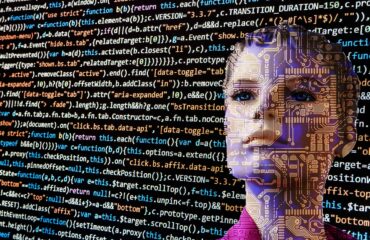Preservation of human memory and imagination in brain-computer interfaces

Artistic rendering of a brain-computer interface
By James Myers
The Quantum Record has previously featured the evolving technology of brain-computer interface (BCI) technology. On November 30, Elon Musk’s company Neuralink announced plans to trial its coin-sized, app-connected BCI technology on a human within 6 months, subject to approval by the U.S. Food and Drug Administration.
Reuters reported that at the three-hour announcement event, Musk said the first two human applications planned for the Neuralink device will be to restore vision and enable movement of muscles in people who cannot do so. Reuters also reported that Neuralink competitor Synchron implanted a device in a patient in the U.S. in July after receiving regulatory clearance in 2021.
Under the headline “Engineering with the Brain”, Neuralink’s website states, “The initial goal of our technology is to help people with paralysis regain independence through the control of computers and mobile devices. Our devices are therefore currently being designed to one day give people the ability to communicate more easily via text or speech synthesis, to follow their curiosity on the web, or to express their creativity through photography, art, or writing apps.”
Beyond the initial goal, the Neuralink website states, “As our technology develops, we want to be able to increase the channels of communication with the brain, accessing more brain areas and new kinds of neural information. We believe this technology has the potential to treat a wide range of neurological disorders, to restore sensory and motor function, and eventually to expand how we interact with each other and experience the world around us.”
What we don’t know about the brain may be more important than what we do know
With the limitations in our knowledge of the brain’s functions, are we ready to “engineer with the brain” and redefine its interactions and experiences?
There remain many unanswered questions on the structure and operation of the human brain, and how its 86 billion neurons and their synapse connections coordinate, store, and recall our perception of reality.
“To make things more complicated, not all neurons are created equal,” writes Rachel Tompa of the Allen Institute to explain the gaps in knowledge of our own brains. “Scientists still don’t know how many different kinds of neurons we have, but it’s likely in the hundreds. Synapses themselves aren’t all the same either. And that’s not even taking into account all the other cells in our brain. Besides neurons, our brains contain lots of blood vessels and a third class of brain cells known collectively as glia — many of which are even more poorly understood than neurons.”
Even if the brain’s structures like neurons were understood, Allen Institute neuroscientist Saskia De Vries describes the problem of determining how they operate together. “We’ve learned a lot more about what the pieces are that make up the brain and how to access them. And now we’re starting to enter a new challenge, which is that instead of recording single cells, we’re now recording hundreds to thousands of cells at once. But a lot of our analytical techniques are still lagging behind. We’re suddenly working with really large datasets that might require more advanced math to really delve into and make sense of.”
There remain many mysteries about the brain’s functions.

2020 Nobel Prize in Physics recipient Sir Roger Penrose, who discovered “that black hole formation is a robust prediction of the general theory of relativity”
For example, anesthetists do not fully understand all the mechanisms by which the brain achieves a suspension of consciousness under anesthesia. Understanding of the causes and treatments of mental illnesses, including depression and schizophrenia, continues to evolve.
Mathematical physicist and Nobel Prize laureate Sir Roger Penrose has investigated, with anesthesiologist Dr. Stuart Hameroff, the theorized quantum states in microtubules within the brain’s neurons. Penrose challenges a common perception that the brain is a calculating device. In a wide-ranging interview with MIT researcher and computer scientist Lex Fridman, Penrose observes that unlike an algorithm, the brain is capable of “transcending rules”.
Difference in computer and brain perception of time
As faulty as it can sometimes be in its reasoning, the human brain has a significant advantage over computers. While the computer can operate at far greater speeds, using far greater power than the body can provide, it can only operate in one direction at a time. The computer throws signals back and forth from one circuit to another in binary sequences, with each signal having a beginning and an end. The brain, however, has no beginning or end to its signalling capacity, and therefore holds far greater potential.
How great? Infinite, potentially. The 86 billion neurons of the brain – imagine them like the wires that carry signals in the computer – act as both computing devices and memory storage devices. The brain does not need to fetch data from a hard drive, transmit it to a central processing unit for calculation, and then save the result on a hard drive. All of those funds are already present in the neuron, where memory and computation are simultaneous events. Since it is not subject to a time delay in data retrieval and processing, the brain has, in the present, access to the entire range of inputs and outputs. We can therefore say the brain “is present”, or equally “is never out of” the present, when it can simultaneously create and record events.

The human brain, obtained from autopsy. Image: Wikipedia
An anesthetist explains, “Neurons have the capacity to learn and aren’t entirely dependant on given or acquired algorithms,” which is a constraint of the computer. “Furthermore, the plasticity of the brain – which is its ability to re-route signals around damaged or malfunctioning areas – allows for a powerful healing.”
In the computer, the process of data retrieval, computation, and storage requires time and vast networks to compute in parallel. Most critically, the storage of data in a computer is prone to sequencing errors as a result of the time differential between retrieval and storage. The problem with the time delay in a computer, as tiny as it might seem with today’s super-fast machines, is that time never stops. Time always has a “present” in which everything in the universe occurs. Although the computer’s data capturing ability might be absent from the present for only a few nanoseconds required to compute data, other events in the universe continue to occur which may or may not have an effect on the outcomes of the computation. Since the computer can’t compute and store simultaneously, it cannot acquire more data in the present while it is computing. The computer, therefore, only records past data, whereas the brain records past and present data simultaneously.
What is reality, and how will the technology change human experience of reality?

The question we might ask Musk is what Neuralink applications are either imagined or under development to expand our interactions and experience? For its goal of “Engineering with the Brain,” has the company adopted any particular philosophical perspective or does it believe the brain is simply a computational device to be amplified with the addition and multiplication of machine inputs?
The business case and economics of Neuralink’s technology have not been disclosed, leaving us to wonder how a profit-generation motive will affect the interactions and experiences of the technology’s human users. In contrast, the mission of BCI company OpenBCI “is to lower the barrier to entry for brain-computer interfacing, while ensuring that these technologies are adopted into the consumer landscape in an ethical way that protects user agency and mental health.” The Quantum Record found no discussion on Neuralink’s website of ethics or user agency in non-medical BCI applications.
What does the future of this technology hold? While science fiction is clearly different from current reality, its appeal can provide a window onto our perception of the connection between the reality of the present and imagined reality of the future.
As human technology develops to give us greater power to shape our future, with mechanisms such as BCI, we might recall the enduring popularity of the 1999 movie The Matrix and the questions it raised. In the movie, the lead character Neo (played by Keanu Reeves) discovered the life he knows is the elaborate deception of an evil cyber-intelligence and leads a battle to destroy the illusion enslaving humanity. “Have you ever had a dream that you were so sure was real?” the movie studio’s website asks. “What if you couldn’t awaken? How would you know the difference between dream and reality?” Although there is yet no sign of an evil cyber-intelligence, these questions seem less far-fetched now, 23 years later with a BCI trial perhaps only 6 months away.

Artist rendering of Plato’s allegory of the cave.
The Matrix and similar visions of the future have become the subject of scholarly discussion.
For instance, cognitive scientist John Vervaeke has discussed the parallels between the themes of The Matrix and Plato’s famous 2,400-year-old allegory of the cave, a subject on which Varvaeke has lectured. In the allegory of the cave in Plato’s Republic, the shackled prisoner in the cave stares at shadows on the wall cast by the torches of unseen men behind him, and, not knowing the difference, thinks the images to be reality.
If you were like the prisoner, surrounded by holographic projections from unknown sources, would you know the difference between fact and fiction?
Questions we might want to ask before implanting our brains
I, perhaps like you, have had dreams that seemed very real but contained events I was unable to control. The question I imagine would be important, if I were ever to hook myself up to a machine implant in my brain, is “where do I end and where does the machine begin?”
To understand whether you or the machine would be in control, wouldn’t that question be important for you too?

Artist rendering of the brain’s complex and continuous connections with external reality. Image by Gerd Altmann from Pixabay
How would we ensure the limits of us always exceed the limits of the machine? Remember, it operates more quickly than our brains can, but with far less imagination (none, actually). The more of our own functions that we allow the machine to control, the more our imaginations will lose their flexibility. Complete loss of imagination could well result in a situation such as Neo found for himself, in The Matrix – don’t you think?
Another critically important question, for me at least, is what the machine would do with the data of “me” to which it is connecting. Is the machine storing “my” data for “its” use, or for the use and benefit or someone else or some company? Much of our life data is already stored and monetized by companies, yielding them great profits. We connect to these companies through their free digital applications – whether it’s a Google search or Facebook interaction or a Twitter posting – and these companies record every detail about us that the law permits. Then they sell the data. We receive no royalty for our data. The law is perhaps too permissive, at least the way I value my data. Do you value your data less than Google, Facebook, and Twitter do? They value it a lot.
Now, imagine the far greater volume of data that could be gleaned from a direct, always-on, connection to your brain. We can only hope that the technology’s designers hold benign intentions at all times, although economic and social history have shown a human tendency to self-interest.
BCI and the Metaverse
Advertising company Meta, which owns Facebook and derived 97% of its revenues in the first half of 2022 from advertising, is promoting its “metaverse” product. The company’s website proclaims, “We believe in the future of connection in the metaverse,” which it says will provide “augmented reality experiences that defy the laws of physics, removing the barriers of self-expression.”
At a cost approaching $2,000, you can equip yourself with a virtual reality headset and accessories, and immerse yourself in an experience “augmented” by the undisclosed algorithms of Meta. Will the users be guaranteed to control their perception of “reality” and the ways in which the technology will “augment” their perceived reality? What data are being stored by the algorithms as they record the user’s reactions to their augmentations, and how much will that data be sold for? Will the privacy of the user be respected more than the company has in the past? The Quantum Record could find no discussion of these questions, or the ethics of virtual reality, on Meta’s website.
The Importance of Avoiding Feedback Loops
If you had a choice to create time, as you would in a metaverse experience (not a “real” time involving other humans, but nonetheless a personal time), would you choose to make an exact image of the present as it is, with all its troubles and potential? It seems Meta’s hope for profitability is that you won’t. But would you aim for something more ideal, a future that is informed by but does not repeat the errors and unpleasant parts of the past?
What knowledge would you use, when you enter the metaverse to create a time and fill it with experiences? What memories would you value and wish to repeat, and which memories would you rather leave behind? How could you predict the outcomes that you will experience in the metaverse, with the actions that you start in it – because you will need time to assess the probabilities of all actions combined. You wouldn’t be able to predict the future at the moment you started a sequence of actions, because you would have to wait to see how they play out over time, and so there could be some risk of a less than enjoyable experience.

The 2009 science fiction hit Avatar featured an augmented experience of unpredictable consequences
The choice to create a replica of the present would, of course, be the easiest because it would require no imagination. A simple copying of all current parameters would suffice, and the future will unfold as it may. The work could all be done by a sufficiently powerful computer algorithm, requiring no human intervention; in fact, a true replica would require only computer generation since any human activity in the creation would change the thing that is being replicated.
To live in a replica of the present world would be to live in a feedback loop, in which the same past becomes the same future becomes the same past and so on repetitively. There would be no “present” in the replica, in the sense that you would not have any options to do other than what you were and are going to do. Without choice, but only outcomes that are guaranteed to replicate with the same inputs and outputs each time, there would be no way to escape the feedback loop.
To aim for a more perfect future, transcending the past, would not only require imagination but also a good measure of knowledge to understand the sequences cause and effect that combine in what we call “time”. Imagination and knowledge require a good deal of human effort to generate, but the reward – as our history of innovation shows – is incalculable.
Preservation of imagination’s incalculable value is worth the effort, at least as I believe. Do you imagine the value of your own imagination in a similar way?
If you do, then the question we could all ask before connecting our brains to devices that record and sell their activity, directly through BCI or virtual reality or indirectly through apps, is, “Where do I end and where does the machine begin?”



